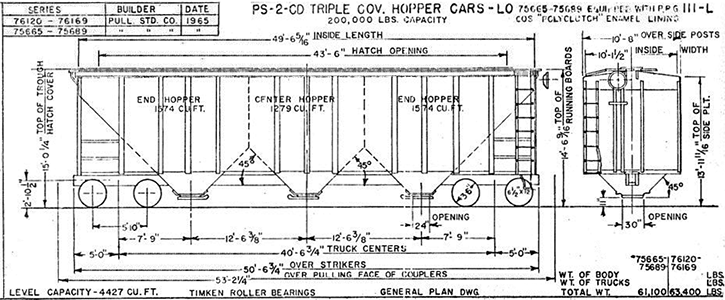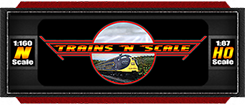 Loading... Please wait...
Loading... Please wait...-
Call us at: 941-500-2288
-
Mail Us at: Trains N Scale P.O. Box 178 Lehigh Acres, FL 33970-0178
- My Account
- Items / $0.00
All prices are in All prices are in USD
Categories
- Home
- Models and Prototypes Blog
- Pullman Standard PS-2CD 4427 Covered Hopper
Pullman Standard PS-2CD 4427 Covered Hopper
Posted by Neville C. Wilson on 30th Jun 2017
Even with Pullman Standard Car Manufacturing Company's passenger car designs and patents spun off to a separate company called Pullman Technology in 1982 (which was eventually sold to Canadian based Bombardier in 1987) and Pullman Standard's remaining railcar manufacturing plants and freight car designs and patents sold to Trinity Industries in 1984, American manufactured Pullman freight and passenger cars were (and to this point in time still are) well known in North America.
When it came to hauling dry bulk goods such as agricultural commodities, cement, clay, dry chemicals, salt, or sand. many railroads and private owners selected the Pullman Standard PS-2 series covered hopper.
Utilized to transport dense and heavy granular products like cement, clay, potash, and sand, due to North American axle weight load limits, two (and later) three bay models were often chosen.
When it came to hauling much lighter commodities such as barley, corn, grain, malt, oats, soybeans, sugar, and wheat, these kinds of products would most commonly be transported in three or four bay covered hoppers.
Unlike two bay models, large four bay cars lend themselves to rapid load and discharge operations.

Pullman Standard PS-2CD 4427 Three Bay Covered Hopper Diagram
While there are a wide range of products covered by the PS-2 designation, it was Pullman's 4427 cubic foot capacity covered hopper that stood out as being the first of the larger capacity models to be manufactured in greater numbers.
Introduced as the PS-2CD (center discharge) in late 1963, the early production "low hip" design 4427 cubic foot capacity cars had low body sides, which concealed most of the hopper bay area.
The manufacturing of "high hip" design raised side 4427 models commenced in November 1966.
Visibly apparent are a few different body style variations.
With the latter style being the most popular choice, the top of the covered hoppers could be fitted with large trough style openings, or, a series of round ones.
With the latter position being most common, brake wheels could be positioned high up on the body end, or, low mounted.
Contemporary unit train operation is a common sight in North America.
Plying North America railways are unit trains consisting of long strings of agricultural commodity laden covered hopper cars, which are seen transporting barley, corn, flour, grain, malt, oats, soybeans, sugar, and wheat from the corn and wheat belt regions of the United States to various markets, mills, and ports.
View additional articles like this one in the Trains N Scale™ Models and Prototypes Blog.
Recent Posts
- » A Quick Look: Intermountain Fox Valley Red Caboose Autoracks Review
- » A Quick Look: Athearn 2293 N UPS Wedge Trailers and Dolly
- » A Quick Look: Atlas N 1993 Ford Explorer SUV 5th Run Review
- » A Quick Look: Eastern Seaboard Models N Metal Wheel-Sets Review
- » A Quick Look: Jacksonville Terminal JTC NSC 53' Well Cars Review
